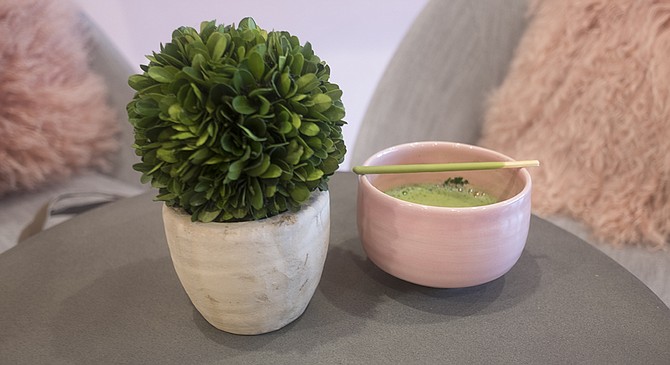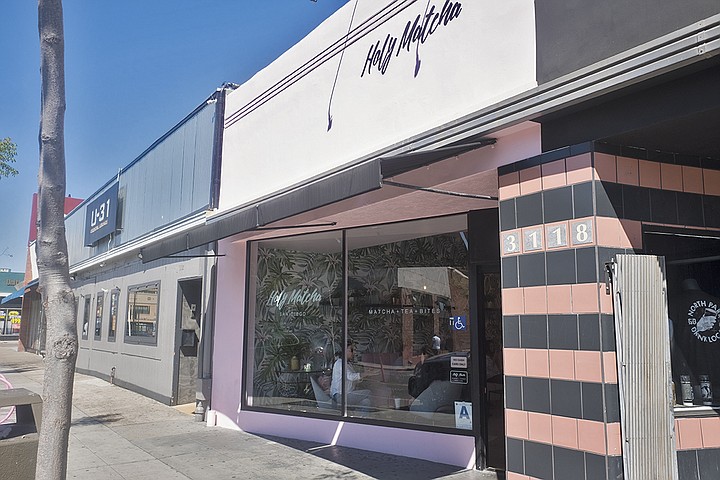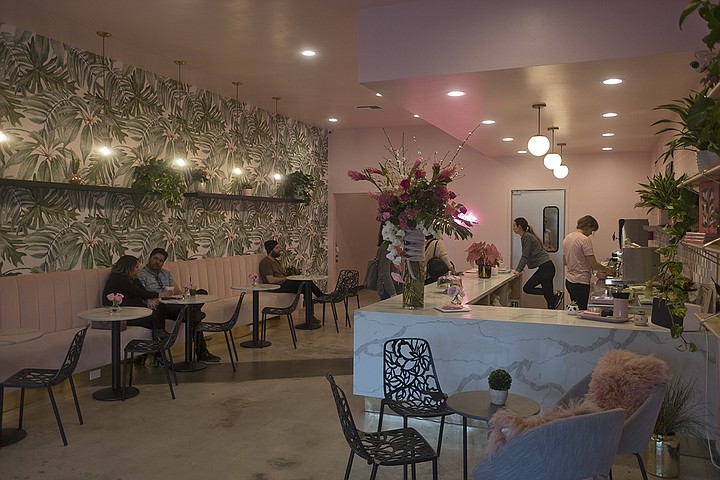 Facebook
Facebook
 X
X
 Instagram
Instagram
 TikTok
TikTok
 Youtube
Youtube

I’m an every day, any time of day coffee drinker, and as long as I am physically able to lift a cup of joe to my lips, that will be the case. Still, while I may not exactly be on the lookout for a coffee replacement, when I heard about the opening of Holy Matcha in North Park, curiosity drove me to give the green tea drink a chance.
Matcha differs from typical green tea in that the leaves have been ground into a powder. So rather than being brewed by steeping tea leaves in water, matcha powder gets stirred into water to make a drinkable solution, like Kool-Aid.

Okay, not exactly like Kool-Aid. The ceremonial Japanese method of making matcha involves a vigorous whisking of the powder in a ceramic cup to create an airy, frothy drink. And since it includes the green tea, leaves and all, the caffeine levels are on par with coffee.

Holy Matcha owner Geraldine Ridaura has a natural intolerance to coffee, so she’s never been able to enjoy it. But matcha suits her just fine, so she’s delved into to the history and process. She’s put together a stylish shop, outfitted with an abundance of pink paint and furnishings to contrast the green beverage and leafy plants. It’s light fare and a variety of matcha drinks, each made using a traditional bamboo whisk, called a chasen.
Surprisingly, the premium matcha is the cheapest on the drink menu, at $4.50. Matcha tends to involve high-quality tea leaves, but there are several different grades of it, based on the leaves used to make it, whether stems were removed, etc. Premium is one of the higher grades of matcha available, and higher still is the ceremonial grade. Used in traditional Japanese tea ceremonies, it’s more finely ground and culled from younger tea leaves, producing a thicker, sweeter tea.
The ceremonial drink goes for 7 bucks at Holy Matcha — a little steep, even by my snooty specialty coffee standards. But knowing matcha would be competing against my fondness for pricey beans, I wanted to give the drink a fair shake.
It was served in a traditional ceramic tea bowl, or chawan — pink, of course — along with a green tea Pocky Stick. While it did taste of green tea, my first take on the bright green drink was that it’s much grassier than what I’m accustomed to sipping at sushi restaurants. However, as I continued to drink, my palate acclimated to the greener flavors and a much deeper, more compelling umami shone through. Between the smooth texture, mellow sweetness, and caffeine, by the time I made it to the bottom of that chawan, I could see myself getting hooked.
The cheaper, premium drink tasted similar, though slightly more bitter and not quite as smooth. I’d suggest ordering this grade as intended, mixed with lemonade ($5) or as a non-dairy latte with almond milk ($5.50). I came back to try an iced version of the latte, lightly sweetened with agave syrup. I’d recommend that for matcha first-timers wishing to ease into the unfamiliar, as a welcome alternative to the ubiquitous iced mocha latte.


I’m an every day, any time of day coffee drinker, and as long as I am physically able to lift a cup of joe to my lips, that will be the case. Still, while I may not exactly be on the lookout for a coffee replacement, when I heard about the opening of Holy Matcha in North Park, curiosity drove me to give the green tea drink a chance.
Matcha differs from typical green tea in that the leaves have been ground into a powder. So rather than being brewed by steeping tea leaves in water, matcha powder gets stirred into water to make a drinkable solution, like Kool-Aid.

Okay, not exactly like Kool-Aid. The ceremonial Japanese method of making matcha involves a vigorous whisking of the powder in a ceramic cup to create an airy, frothy drink. And since it includes the green tea, leaves and all, the caffeine levels are on par with coffee.

Holy Matcha owner Geraldine Ridaura has a natural intolerance to coffee, so she’s never been able to enjoy it. But matcha suits her just fine, so she’s delved into to the history and process. She’s put together a stylish shop, outfitted with an abundance of pink paint and furnishings to contrast the green beverage and leafy plants. It’s light fare and a variety of matcha drinks, each made using a traditional bamboo whisk, called a chasen.
Surprisingly, the premium matcha is the cheapest on the drink menu, at $4.50. Matcha tends to involve high-quality tea leaves, but there are several different grades of it, based on the leaves used to make it, whether stems were removed, etc. Premium is one of the higher grades of matcha available, and higher still is the ceremonial grade. Used in traditional Japanese tea ceremonies, it’s more finely ground and culled from younger tea leaves, producing a thicker, sweeter tea.
The ceremonial drink goes for 7 bucks at Holy Matcha — a little steep, even by my snooty specialty coffee standards. But knowing matcha would be competing against my fondness for pricey beans, I wanted to give the drink a fair shake.
It was served in a traditional ceramic tea bowl, or chawan — pink, of course — along with a green tea Pocky Stick. While it did taste of green tea, my first take on the bright green drink was that it’s much grassier than what I’m accustomed to sipping at sushi restaurants. However, as I continued to drink, my palate acclimated to the greener flavors and a much deeper, more compelling umami shone through. Between the smooth texture, mellow sweetness, and caffeine, by the time I made it to the bottom of that chawan, I could see myself getting hooked.
The cheaper, premium drink tasted similar, though slightly more bitter and not quite as smooth. I’d suggest ordering this grade as intended, mixed with lemonade ($5) or as a non-dairy latte with almond milk ($5.50). I came back to try an iced version of the latte, lightly sweetened with agave syrup. I’d recommend that for matcha first-timers wishing to ease into the unfamiliar, as a welcome alternative to the ubiquitous iced mocha latte.
Comments